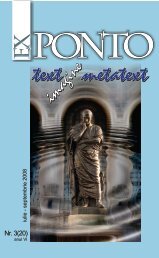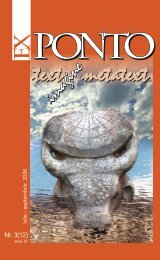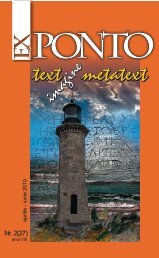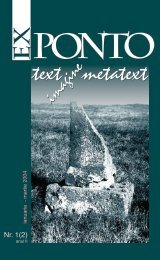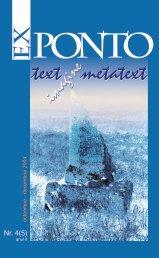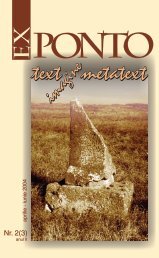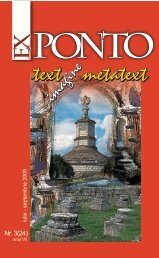Nr. 2 (19) anul VI / aprilie-iunie 2008 - ROMDIDAC
Nr. 2 (19) anul VI / aprilie-iunie 2008 - ROMDIDAC
Nr. 2 (19) anul VI / aprilie-iunie 2008 - ROMDIDAC
You also want an ePaper? Increase the reach of your titles
YUMPU automatically turns print PDFs into web optimized ePapers that Google loves.
may sound surrealistic, “aestheticism” was an inadmissible crime at that time.<br />
To deliberately avoid writing or painting about the patriotic and social topics<br />
was an offence against the working class, which could not identify its ideals<br />
with the gratuity expressed in the formalist artworks. Since the foremost aim<br />
of the social realistic art was to educate people, artworks, which ignored or did<br />
not emphasize enough the importance of the new era, the construction of the<br />
new individual, and the gratitude to the communist party, were dismissed. In<br />
this paper I will analyze how two Romanian visual artists tried to cope with the<br />
ideologically loaded requirements of the Communist Party and yet preserved<br />
their artistic identity under these difficult circumstances. Ion Popescu Gopo<br />
chose, as many Romanian writers and artists did, the so-called aesthetic<br />
escape, which meant to wrap his topics into an artistic expression with<br />
apparently no obvious reference to his ideological context, but close enough<br />
to the official recommendations regarding the content of art. In contrast, the<br />
younger caricaturist, Mihai Stanescu, preferred to confront the communist<br />
ideology with its own caricature and suffered from being mostly censored in<br />
Romania, but published abroad. Neither the aesthetic defeatism of Gopo, nor<br />
the ideological engagement of Stanescu has survived. A possible explanation<br />
of them being forgotten by the public is the fact that the ideology of their time<br />
is no longer with us and its corresponding aesthetic programs are obsolete.<br />
Ex Ponto nr.2, <strong>2008</strong><br />
Ion Popescu-Gopo<br />
The world of animation reflected the same ideology, and even worse,<br />
it had to face scarcity of specific means of production and to overcome the<br />
preconceived idea that another artistic expression should add something<br />
distinctively different in the chorus of arts worshiping the party and the progress<br />
it generated.<br />
Before <strong>19</strong>50 the first Romanian cartoons adapted Ion Creanga’s stories<br />
very rudimentarily to the new medium. After <strong>19</strong>50 their subjects came from<br />
the excessively moralizing literature of Socialist Realism which transformed<br />
them into a series of schematic drawings. Ion Popescu Gopo paid the price to<br />
ideology in order to see his cartoons distributed. Cartoons such as: following<br />
the Albina si porumbelul [The Bee and the Dove], Ratoiul neascultator [The<br />
Nasty Duck], Cei doi iepurasi [Two Little Rabbits], Marinica, Surubul lui Marinica<br />
[Marinica’s Screw], and Fetita mincinoasa [The Lying Little Girl] replaced the<br />
former characters identified as Romanian with allegorical representations<br />
of the Marxist dialectics. From this ideologically successful but artistically<br />
defective experience, Gopo seemed to learn both how to meet the ideological<br />
standards and how to avoid being too explicit. Looking back at Gopo’s cartoons<br />
in the context of the times, one may see that he did not submissively obey the<br />
Soviet aesthetic program, although he had gotten acquainted with it during<br />
his studies in Moscow, but there were coincidences between the themes of<br />
his cartoons and the party documents.<br />
In <strong>19</strong>57, Gopo’s The Short History was awarded the Palme d’Or at<br />
Cannes, France. On the one hand, this international success was to protect<br />
him against any potential inconveniences from Romanian institutions, on the<br />
other, it encouraged him to continue the series of the Little Man. His character<br />
may be considered a modern image of the medieval Everyman, who crossed<br />
the ages spiritually unchanged. He only changed clothes, technologies, and<br />
symbols, remaining the representation of popular masses who had overcome<br />
any of the aggressive exterior factors such as natural disasters and wild beasts<br />
162






